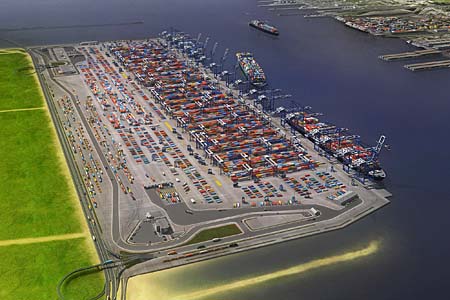 The U.S. Army Corps of Engineers (USACE) and the Virginia Port Authority (VPA) are partnering to construct the Craney Island Eastward Expansion project.
The U.S. Army Corps of Engineers (USACE) and the Virginia Port Authority (VPA) are partnering to construct the Craney Island Eastward Expansion project.
The Craney Island Dredged Material Management Area (CIDMMA) was authorized by the River and Harbor Act of 1946 and constructed from 1956-1958. The Federally-owned facility is operated by USACE and is used by private interests, local municipalities, Federal and Commonwealth of Virginia government agencies for the disposal of dredged material from Norfolk Harbor and its adjacent waterways, including the Elizabeth and Nansemond Rivers.
Originally designed for a 20 year life span, USACE has been studying ways to extend the life of CIDMMA since the 1970s. In 1997 the U.S. House of Representatives Committee on Transportation and Infrastructure authorized Norfolk District to prepare a Feasibility Study to determine the feasibility of expanding Craney Island into the east, and to consider rapid filling of the new dredge material site to provide an area for a new marine terminal. The Feasibility Study, concluded in 2006, determined that the existing CIDMMA would reach capacity in 2025 and the VPA would run out of cargo handling capacity in 2011. The objectives of the study were then focused on providing a solution that could address both of these capacity shortfalls. In accordance with the National Environmental Policy Act (NEPA), USACE evaluated all reasonable alternatives to avoid and minimize impacts to the environment.
The Corps evaluated a total of 51 alternatives for dredged material placement and a total of 25 port alternatives for container handling capacity. An eastward expansion emerged as the best solution to increase the capacity of CIDMMA for dredged material and also provide an area to construct the fourth marine terminal. The final Feasibility Study recommended an eastward expansion, with a future project planned to strengthen the western dikes. The Feasibility Study and Environmental Impact Statement (EIS) were approved by the Chief of Engineers of the Army Corps of Engineers, Lt. Gen. Carl A. Stock, in October of 2006.
Contracts for the 522-acre expansion project will be bid in phases to match project funding. The initial eastward expansion construction contract, which includes construction of the containment cell cross dikes will be advertised in summer 2010 and awarded in early fall 2010. Additional contracts bid in 2010 include the first environmental mitigation project and Naval pipeline relocation. Main dike construction, completion of the cross dikes, and additional mitigation projects will be bid over the course of the next several years. The undertaking will generate $6 billion in National Economic Development (NED) benefits over the 50-year life of the project.